Quantifying Dissolved Organic Carbon Efflux from Drained Peatlands in Hemiboreal Latvia
Abstract
1. Introduction
2. Materials and Methods
2.1. Research Sites
2.2. Data Collection and Measurements of Environmental Variables
2.3. Evapotranspiration and Runoff Estimation
2.4. Statistical Analysis
3. Results
3.1. Variation in DOC Concentration in Groundwater
3.2. Runoff and Evapotranspiration
3.3. DOC Efflux from Peatlands
3.4. Evaluation of Affecting Factors
4. Discussion
4.1. DOC Efflux and Affecting Factors
4.2. DOC Concentrations and Affecting Factors
5. Conclusions
Author Contributions
Funding
Data Availability Statement
Acknowledgments
Conflicts of Interest
References
- Bragg, O.M. Hydrology of peat-forming wetlands in Scotland. Sci. Total Environ. 2002, 294, 111–129. [Google Scholar] [CrossRef]
- Nikodemus, O.; Kārkliņš, A.; Kļaviņš, A.; Melecis, V. Augsnes Ilgtspējīga Izmantošana un Aizsardzība; LU Akadēmiskais Apgāds: Rīga, Latvia, 2008. [Google Scholar]
- Page, S.E.; Baird, A.J. Peatlands and Global Change: Response and Resilience. Annu. Rev. Environ. Resour. 2016, 41, 35–57. [Google Scholar] [CrossRef]
- Parish, F.; Sirin, A.; Charman, D.; Joosten, H.; Minayeva, T.; Silvius, M.; Stringer, L. Assessment on Peatlands, Biodiversity and Climate Change: Main Report; Global Environment Centre: Kuala Lumpur, Malaysia; Wetlands International: Wageningen, The Netherlands, 2008. [Google Scholar]
- Joosten, H.; Couwenberg, J. Are Emission Reductions from Peatlands MRV-Able? Wetlands International: Wageningen, The Netherlands, 2009. [Google Scholar]
- Xu, J.; Morris, P.J.; Liu, J.; Holden, J. PEATMAP: Refining estimates of global peatland distribution based on a meta-analysis. Catena 2018, 160, 134–140. [Google Scholar] [CrossRef]
- Bonan, G.; Pollard, D.; Thompson, S. Effects of boreal forest vegetation on global climate. Nature 1992, 359, 716–718. [Google Scholar] [CrossRef]
- Frolking, S.; Talbot, J.; Jones, M.C.; Treat, C.C.; Kauffman, J.B.; Tuittila, E.-S.; Roulet, N. Peatlands in the Earth’s 21st century climate system. Environ. Rev. 2011, 19, 371–396. [Google Scholar] [CrossRef]
- Price, J.S.; Heathwaite, A.L.; Baird, A.J. Hydrological processes in abandoned and restored peatlands: An overview of management approaches. Wetl. Ecol. Manag. 2003, 11, 65–83. [Google Scholar] [CrossRef]
- Höper, H.; Augustin, J.; Cagampan, J.P.; Drösler, M.; Lundin, L.; Moors, E.J.; Vasander, H.; Waddington, J.M.; Wilson, D. Restoration of peatlands and greenhouse gas balances. In Peatlands and Climate Change; Strack, M., Ed.; International Peat Society: Jyväskylä, Finland, 2008; pp. 182–211. [Google Scholar]
- Ozola, I.; Dauskane, I.; Aunina, I.; Stivrins, N. Paludiculture in Latvia—Existing Knowledge and Challenges. Land 2023, 12, 2039. [Google Scholar] [CrossRef]
- Ivanovs, J.; Haberl, A.; Melniks, R. Modeling Geospatial Distribution of Peat Layer Thickness Using Machine Learning and Aerial Laser Scanning Data. Land 2024, 13, 466. [Google Scholar] [CrossRef]
- Couwenberg, J. Emission Factors for Managed Peat Soils: An Analysis of IPCC Default Values; Wetlands International: Bonn, Germany, 2009. [Google Scholar]
- Escobar, D.; Belyazid, S.; Manzoni, S. Back to the Future: Restoring Northern Drained Forested Peatlands for Climate Change Mitigation. Front. Environ. Sci. 2022, 10, 834371. [Google Scholar] [CrossRef]
- Mos, H.; Harun, M.H.; Jantan, N.M.; Hashim, Z.; Ibrahim, A.S.; Yusup, Y. Differences in CO2 Emissions on a Bare-Drained Peat Area in Sarawak, Malaysia, Based on Different Measurement Techniques. Agriculture 2023, 13, 622. [Google Scholar] [CrossRef]
- Evans, C.D.; Renou-Wilson, F.; Strack, M. The role of waterborne carbon in the greenhouse gas balance of drained and re-wetted peatlands. Aquat. Sci. 2016, 78, 573–590. [Google Scholar] [CrossRef]
- Sawicka, K.; Clark, J.M.; Vanguelova, E.; Monteith, D.T.; Wade, A.J. Spatial properties affecting the sensitivity of soil water dissolved organic carbon long-term median concentrations and trends. Sci. Total Environ. 2021, 780, 146670. [Google Scholar] [CrossRef]
- Kolka, R.; Weishampel, P.; Fröberg, M. Measurement and Importance of Dissolved Organic Carbon. In Field Measurements for Forest Carbon Monitoring; Hoover, C.M., Ed.; Springer: Dordrecht, The Netherlands, 2008; pp. 171–176. [Google Scholar]
- Hollands, C.; Shannon, V.L.; Sawicka, K.; Vanguelova, E.I.; Benham, S.E.; Shaw, L.J.; Clark, J.M. Management impacts on the dissolved organi carbon release from deadwood, ground vegetation and the forest floor in a temperate Oak woodland. Sci. Total Environ. 2022, 805, 150399. [Google Scholar] [CrossRef]
- Neff, J.C.; Asner, G.P. Dissolved Organic Carbon in Terrestrial Ecosystems: Synthesis and a Model. Ecosystems 2001, 4, 29–48. [Google Scholar] [CrossRef]
- Michalzik, B.; Kalbitz, K.; Park, J.-H.; Solinger, S.; Matzner, E. Fluxes and concentrations of dissolved organic carbon and nitrogen—A synthesis for temperate forests. Biogeochemistry 2001, 52, 173–205. [Google Scholar] [CrossRef]
- Kalbitz, K.; Solinger, S.; Park, J.-H.; Michalzik, B.; Matzner, E. Controls on the Dynamics of Dissolved Organic Matter in Soils: A Review. Soil Sci. 2000, 165, 277–304. [Google Scholar] [CrossRef]
- Aitkenhead, J.A.; McDowell, W.H. Soil C:N ratio as a predictor of annual riverine DOC flux at local and global scales. Glob. Biogeochem. Cycles 2000, 14, 127–138. [Google Scholar] [CrossRef]
- Allen, R.G.; Pereira, L.S.; Raes, D.; Smith, M. Crop Evapotranspiration (Guidlines for Computing Crop Water Requirements); FAO: Rome, Italy, 1998. [Google Scholar]
- Sarkkola, S.; Hokka, H.; Koivusalo, H.; Nieminen, M.; Ahti, E.; Paivanen, J.; Laine, J. Role of tree stand evapotranspiration in maintaining satisfactory drainage conditions in drained peatlands. Can. J. For. Res. 2010, 40, 1485–1496. [Google Scholar] [CrossRef]
- Kløve, B.; Berglund, K.; Berglund, Ö.; Weldon, S.; Maljanen, M. Future options for cultivated Nordic peat soils: Can land management and rewetting control greenhouse gas emissions? Environ. Sci. Policy 2017, 69, 85–93. [Google Scholar] [CrossRef]
- LEGMC Climate Portal. Available online: https://klimats.meteo.lv/operativais_klimats/laikapstaklu_apskati/arhivs/2021/gads/ (accessed on 30 April 2023).
- Comet System. Available online: https://www.cometsystem.com/products/temperature-data-logger-for-four-external-pt1000-probes/reg-u0141 (accessed on 30 October 2023).
- Gasmet. Available online: https://www.gasmet.com/cases/gas-analyzer-builds-complete-picture-of-contamination/ (accessed on 30 October 2023).
- LVS EN ISO 17025:2018; General Requirements for the Competence of Testing and Calibration Laboratories. Ltd. “Latvijas Standarts” (LVS): Riga, Latvia, 2018.
- LVS ISO 10523:2012; Water Quality—Determination of pH (ISO 10523:2008). Ltd. “Latvijas Standarts” (LVS): Riga, Latvia, 2012.
- LVS EN 27888:1993; Water Quality—Determination of Electrical Conductivity. Ltd. “Latvijas Standarts” (LVS): Riga, Latvia, 1993.
- Skalar. Formacs Total Organic Carbon/Total Nitrogen Analyzers. Available online: https://www.skalar.com/products/formacs-total-organic-carbon-total-nitrogen-analyzers (accessed on 30 October 2023).
- LVS EN 12260:2004; Water Quality—Determination of Nitrogen. Ltd. “Latvijas Standarts” (LVS): Riga, Latvia, 2004.
- LVS EN 1484:2000; Water Quality—Guidelines for the Determination of Total Organic Carbon (TOC) and Dissolved Organic Carbon (DOC). Ltd. “Latvijas Standarts” (LVS): Riga, Latvia, 2000.
- Thermo Fisher Scientific. QuantStudio™ 7 Flex Real-Time PCR System. Available online: https://www.thermofisher.com/order/catalog/product/942350023500 (accessed on 30 October 2023).
- LVS EN ISO 7980:2000; Water Quality—Determination of Calcium and Magnesium—Atomic Absorption Spectrometric Method. Ltd. “Latvijas Standarts” (LVS): Riga, Latvia, 2000.
- LVS ISO 9964-3:2000; Water Quality—Determination of Sodium and Potassium—Part 3: Flame Photometric Method. Ltd. “Latvijas Standarts” (LVS): Riga, Latvia, 2000.
- Vanags-Duka, M.; Bārdule, A.; Butlers, A.; Upenieks, E.M.; Lazdiņš, A.; Purviņa, D.; Līcīte, I. GHG Emissions from Drainage Ditches in Peat Extraction Sites and Peatland Forests in Hemiboreal Latvia. Land 2022, 11, 2233. [Google Scholar] [CrossRef]
- Monteith, J.L. Evaporation and environment. In Symposia of the Society for Experimental Biology; Cambridge University Press: Cambridge, UK, 1965; Volume 19, pp. 205–234. [Google Scholar]
- Zotarelli, L.; Dukes, M.D.; Romero, C.C.; Migliaccio, K.W.; Morgan, K.T. Step by Step Calculation of the Penman-Monteith Evapotranspiration (FAO-56 Method); Agricultural and Biological Engineering Department, UF/IFAS Extension: Gainesville, FL, USA, 2015. [Google Scholar]
- R Core Team. The R Project for Statistical Computing. Available online: https://www.R-project.org (accessed on 25 July 2023).
- Wei, T.; Simko, V. R Package ‘Corrplot’: Visualization of a Correlation Matrix (Version 0.92). 2021. Available online: https://github.com/taiyun/corrplot (accessed on 20 December 2023).
- Aphalo, P. ggpmisc: Miscellaneous Extensions to ‘ggplot2’. R Package Version 0.5.3. 2023. Available online: https://CRAN.R-project.org/package=ggpmisc (accessed on 20 December 2023).
- Kucheryavskiy, S. mdatools-R package for chemometrics. Chemom. Intell. Lab. Syst. 2020, 198, 103937. [Google Scholar] [CrossRef]
- ggplot2: Create Elegant Data Visualisations Using the Grammar of Graphics. Available online: https://cran.r-project.org/web/packages/ggplot2/index.html (accessed on 30 July 2023).
- Rosset, T.; Binet, S.; Rigal, F.; Gandois, L. Peatland dissolved organic carbon export to surface waters: Global significance and effects of anthropogenic disturbance. Geophys. Res. Lett. 2022, 49, e2021GL096616. [Google Scholar] [CrossRef]
- Evans, C.D.; Williamson, J.M.; Kacaribu, F.; Irawan, D.; Suardiwerianto, Y.; Hidayat, M.F.; Laurén, A.; Page, S.E. Rates and spatial variability of peat subsidence in Acacia plantation and forest landscapes in Sumatra, Indonesia. Geoderma 2019, 338, 410–421. [Google Scholar] [CrossRef]
- IPCC. 2013 Supplement to the 2006 IPCC Guidelines for National Greenhouse Gas Inventories: Wetlands; Hiraishi, T., Krug, T., Tanabe, K., Srivastava, N., Baasansuren, J., Fukuda, M., Troxler, T.G., Eds.; IPCC: Geneva, Switzerland, 2014. [Google Scholar]
- Jaiswal, R.K.; Ali, S.; Bharti, B. Comparative evaluation of conceptual and physical rainfall–runoff models. Appl. Water Sci. 2020, 10, 48. [Google Scholar] [CrossRef]
- Launiainen, S.; Guan, M.; Salmivaara, A.; Kieloaho, A.-J. Modeling boreal forest evapotranspiration and water balance at stand and catchment scales: A spatial approach. Hydrol. Earth Syst. Sci. 2019, 23, 3457–3480. [Google Scholar] [CrossRef]
- Filep, T.; Rékási, M. Factors controlling dissolved organic carbon (DOC), dissolved organic nitrogen (DON) and DOC/DON ratio in arable soils based on a dataset from Hungary. Geoderma 2011, 162, 312–318. [Google Scholar] [CrossRef]
- Yallop, A.R.; Clutterbuck, B. Land management as a factor controlling dissolved organic carbon release from upland peat soils 1: Spatial variation in DOC productivity. Sci. Total Environ. 2009, 407, 3803–3813. [Google Scholar] [CrossRef]
- Rasilo, T.; Ojala, A.; Huotari, J.; Starr, M.; Pumpanen, J. Concentrations and quality of DOC along the terrestrial–aquatic continuum in a boreal forested catchment. Freshw. Sci. 2015, 34, 440–455. [Google Scholar] [CrossRef]
- Thompson, L.M.; Low, M.; Shewan, R.; Schulze, C.; Simba, M.; Sonnentag, O.; Tank, S.E.; Olefeldt, D. Concentrations and yields of mercury, methylmercury, and dissolved organic carbon from contrasting catchments in the discontinuous permafrost region, western Canada. Water Resour. Res. 2023, 59, e2023WR034848. [Google Scholar] [CrossRef]
- Zhu, X.; Berninger, F.; Chen, L. Several mechanisms drive the heterogeneity in browning across a boreal stream network. ESS Open Archive, 2023; preprint. [Google Scholar] [CrossRef]
- Ledesma, J.L.J.; Futter, M.N.; Laudon, H.; Evans, C.D.; Köhler, S.J. Boreal forest riparian zones regulate stream sulfate and dissolved organic carbon. Sci. Total Environ. 2016, 560–561, 110–122. [Google Scholar] [CrossRef]
- Laudon, H.; Sponseller, R.A.; Bishop, K. From legacy effects of acid deposition in boreal streams to future environmental threats. Environ. Res. Lett. 2021, 16, 015007. [Google Scholar] [CrossRef]
- Lawrence, G.B.; Roy, K.M. Ongoing increases in dissolved organic carbon are sustained by decreases in ionic strength rather than decreased acidity in waters recovering from acidic deposition. Sci. Total Environ. 2021, 766, 142529. [Google Scholar] [CrossRef]
- Kerr, J.G.; Eimers, M.C. Decreasing soil water Ca2+ reduces DOC adsorption in mineral soils: Implications for long-term DOC trends in an upland forested catchment in southern Ontario, Canada. Sci. Total Environ. 2012, 427–428, 298–307. [Google Scholar] [CrossRef]
- Reemtsma, T.; Bredow, A.; Gehring, M. The natura and kinetics of organic matter release from soil by salt solutions. Eur. J. Soil Sci. 1999, 50, 53–64. [Google Scholar] [CrossRef]
- Güngör, E.B.O.; Bekbölet, M. Zinc release by humic and fulvic acid as influenced by pH, complexation and DOC sorption. Geoderma 2010, 159, 131–138. [Google Scholar] [CrossRef]
- Goulding, K.W.T. Soil acidification and the importance of liming agricultural soils with particular reference to the United Kingdom. Soil Use Manag. 2016, 32, 390–399. [Google Scholar] [CrossRef]
- Deru, J.G.C.; Hoekstra, N.; van Agtmaal, M.; Bloem, J.; de Goede, R.; Brussaard, L.; van Eekeren, N. Effects of Ca:Mg ratio and pH on soil chemical, physical and microbiological properties and grass N yield in drained peat soil. N. Z. J. Agric. Res. 2023, 66, 61–82. [Google Scholar] [CrossRef]
- Grover, S.P.; Butterly, C.R.; Wang, X.; Tang, C. The short-term effects of liming on organic carbon mineralisation in two acidic soils as affected by different rates and application depths of lime. Biol. Fertil. Soils 2017, 53, 431–443. [Google Scholar] [CrossRef]
- Makovskis, K.; Dūmiņš, K.; Štāls, T.A.; Vendiņa, V.; Bārdule, A.; Lazdiņa, D. Long-Term Effect of Wood Ash and Wastewater Sludge Fertilization on Tree Growth in Short-Rotation Forest Plantations on Abandoned Agricultural Land: A Case Study. Sustainability 2023, 15, 16272. [Google Scholar] [CrossRef]
- Wind-Mulder, H.L.; Rochefort, L.; Vitt., D.H. Water and peat chemistry comparisons of natural and post-harvested peatlands across Canada and their relevance to peatland restoration. Ecol. Eng. 1996, 7, 161–181. [Google Scholar] [CrossRef]
- Sapek, B. Relationship between dissolved organic carbon and calcium and megnesium in soil water phase and their uptake by meadow vegetation. J. Water Land Dev. 2013, 19, 69–76. [Google Scholar] [CrossRef]
- Fröberg, M.; Berggren, D.; Bergkvist, B.; Bryant, C.; Mulder, J. Concentration and Fluxes of Dissolved Organic Carbon (DOC) in Three Norway Spruce Stands along a Climatic Gradient in Sweden. Biogeochemistry 2006, 77, 1–23. [Google Scholar] [CrossRef]
- Āboltiņš, O.; Dreimanis, A. Glacigenic deposits in Latvia. In Glacial Deposits in North-East Europe; Ehlers, J., Kozarski, S., Gibbard, P., Eds.; Balkema, Rotterdam/Brookfield; CRC Press: Boca Raton, FL, USA, 1995; pp. 105–113. [Google Scholar]
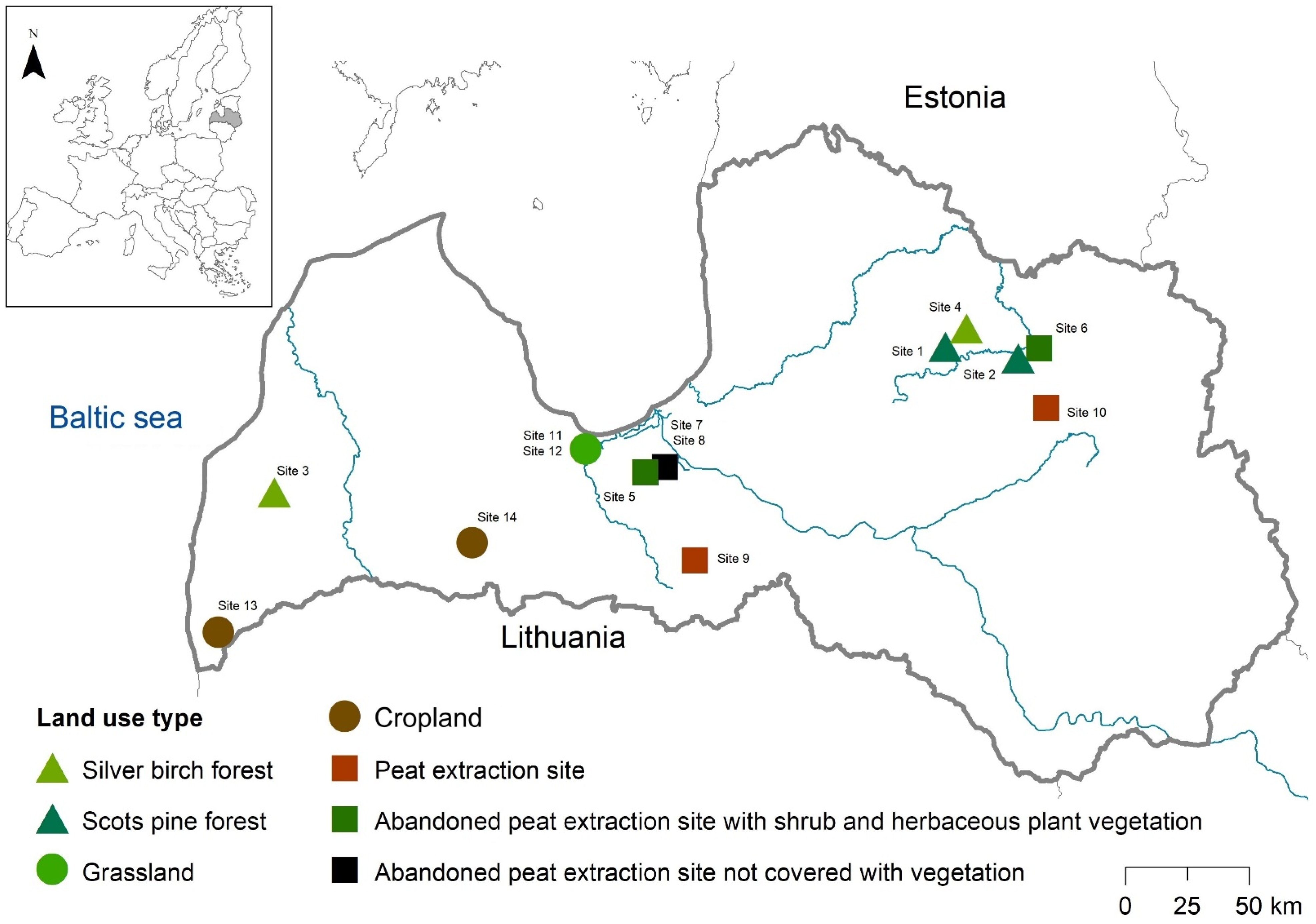


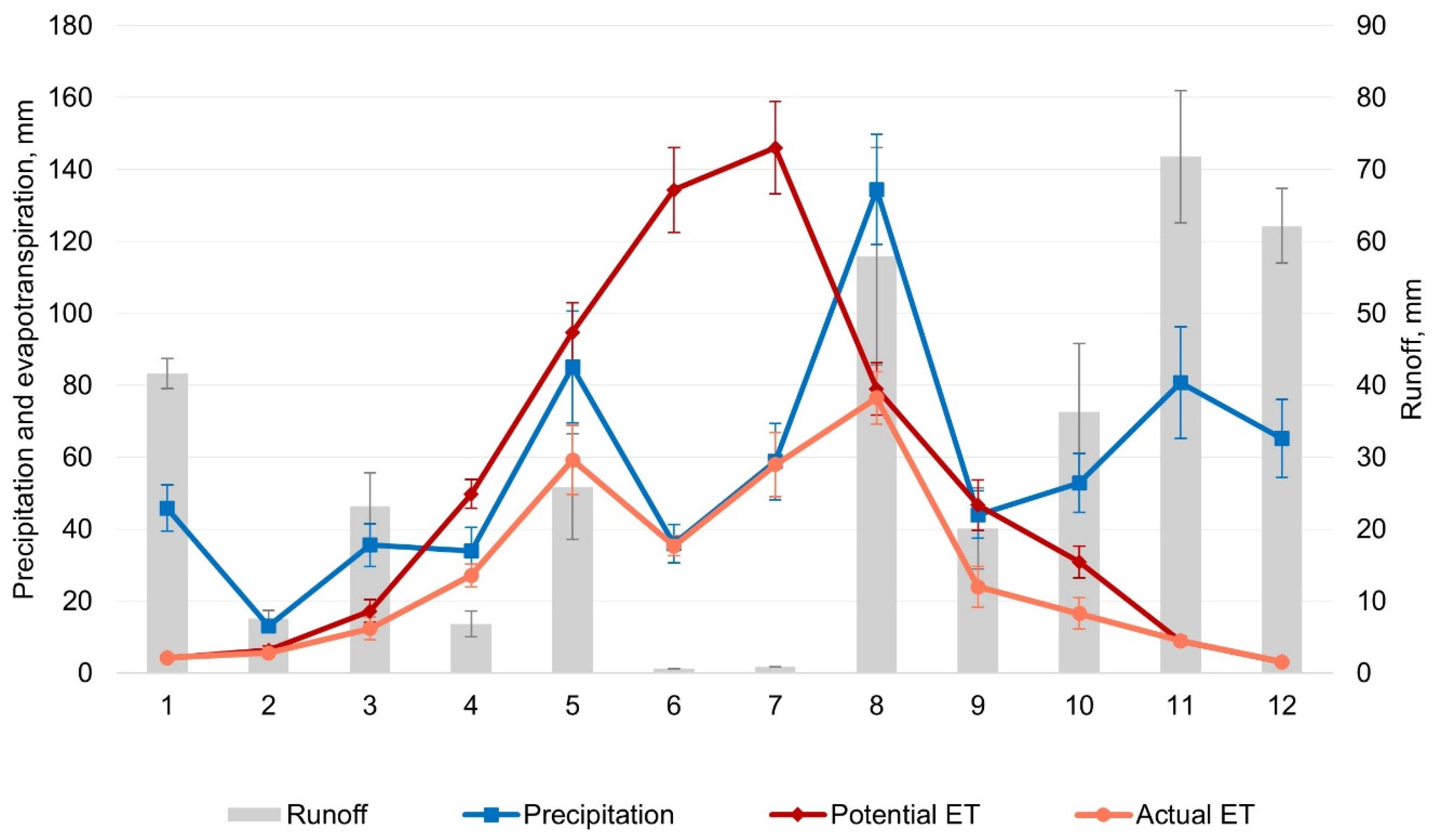


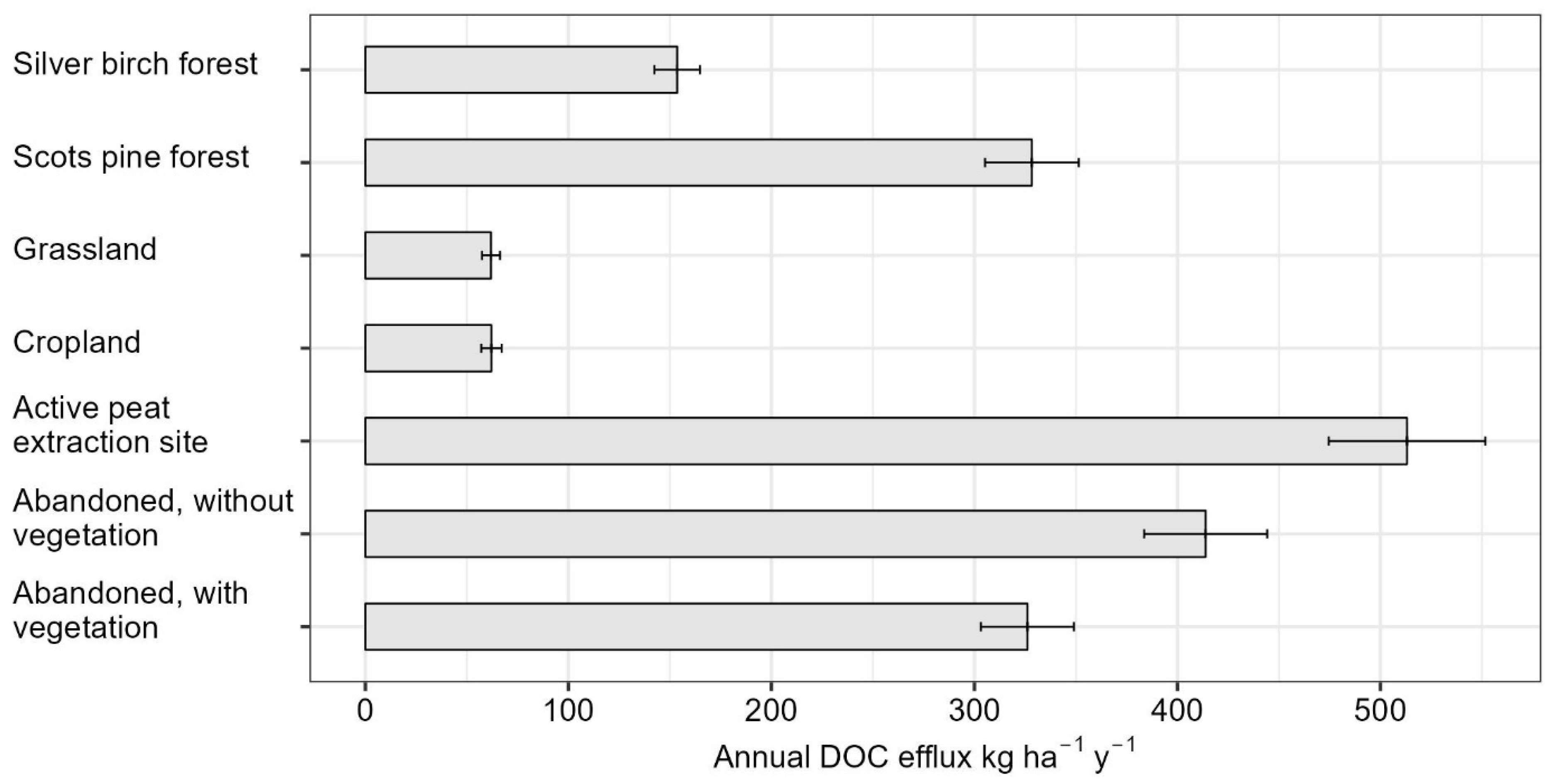
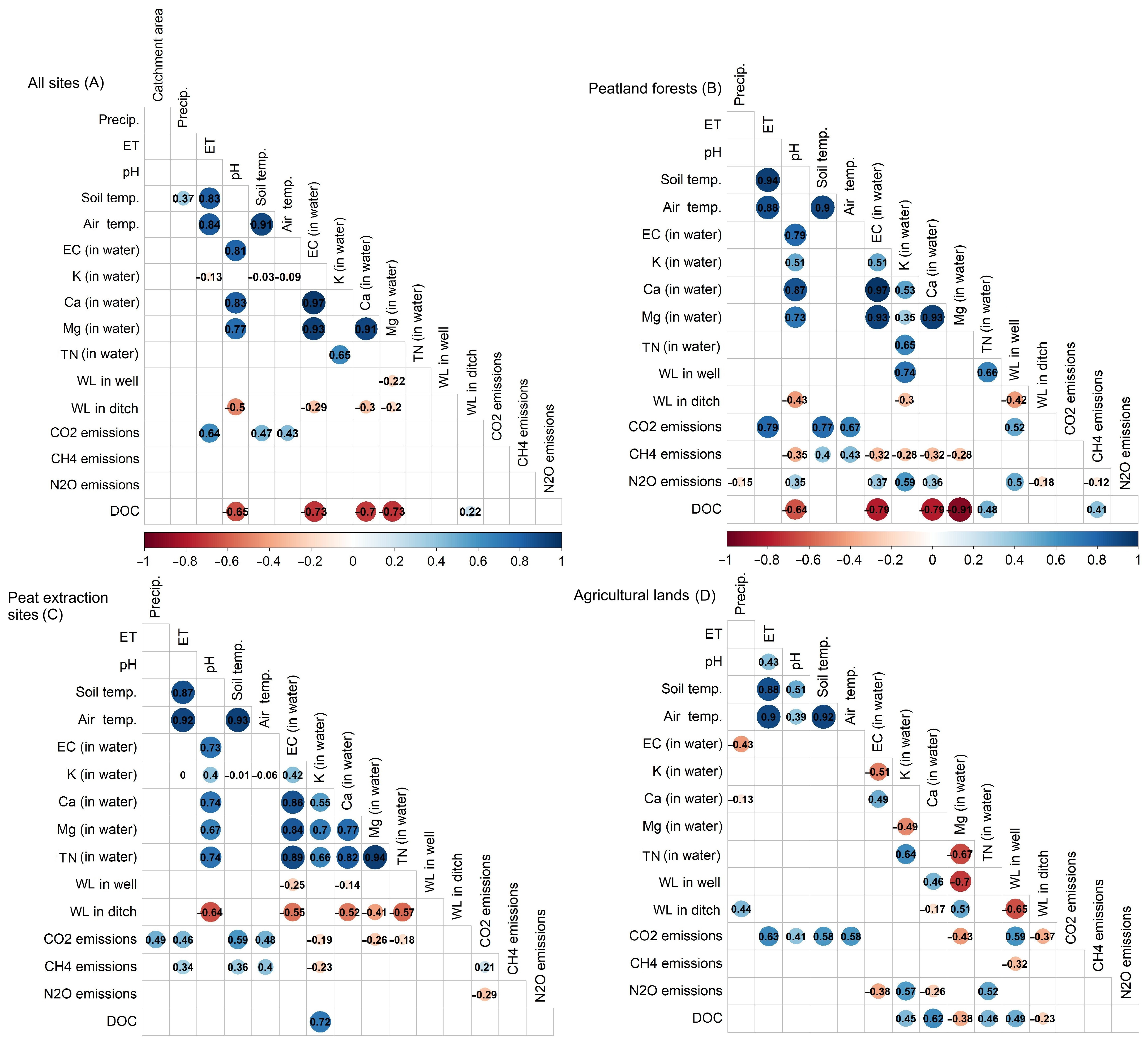
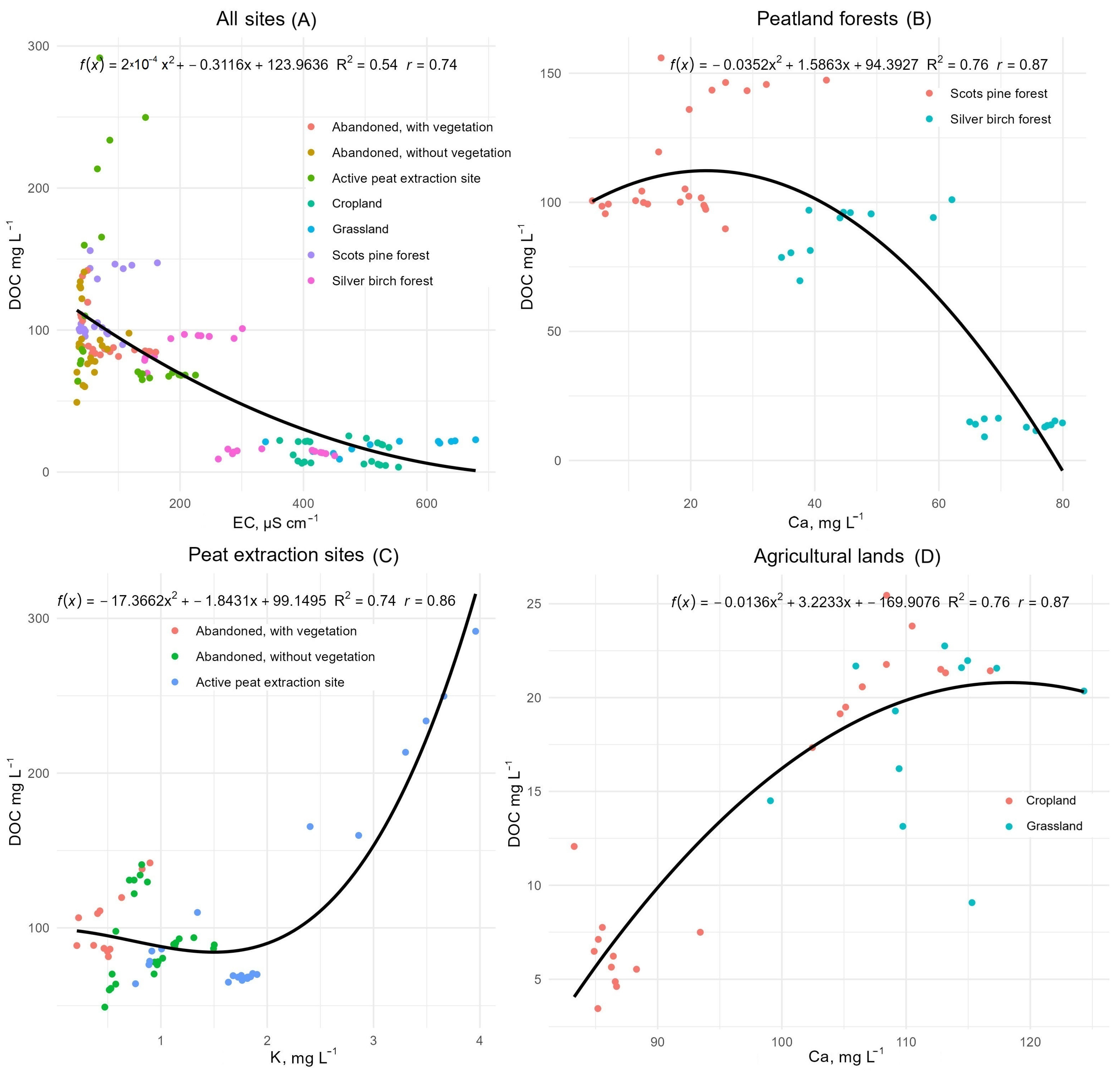
| Land Use Type, Tree Specie | Research Site | Number of Trees ha−1 | Tree Diameter at Breast Height, cm | Tree Height, cm |
|---|---|---|---|---|
| Scots pine forest | Site 1 | 2060 | 21.3 ± 0.9 | 18.8 ± 1.3 |
| Scots pine forest | Site2 | 3920 | 7.9 ± 0.4 | 8.6 ± 0.5 |
| Silver birch forest | Site3 | 800 | 14.2 ± 0.8 | 13.7 ± 1.4 |
| Silver birch forest | Site4 | 1940 | 15.3 ± 0.3 | 16.8 ± 0.7 |
| Land Use Type | Research Site | Ditch Catchment Area, ha | Ditch Width, cm | Ditch Depth, cm | Coordinates (EPSG: 4326) | |
|---|---|---|---|---|---|---|
| X | Y | |||||
| Scots pine forest | Site1 | 192 | 205 | 31 | 25.9943 | 57.2681 |
| Site 2 | 96 | 212 | 54 | 26.4794 | 57.2165 | |
| Silver birch forest | Site 3 | 21 | 260 | 57 | 21.5200 | 56.7274 |
| Site 4 | 192 | 269 | 52 | 26.1401 | 57.3312 | |
| Abandoned peat extraction site with shrub and herbaceous plant vegetation | Site 5 | 95 | 153 | 75 | 23.9802 | 56.8246 |
| Site 6 | 81 | 207 | 69 | 26.6256 | 57.2494 | |
| Abandoned peat extraction site with bare peat | Site 7 | 131 | 133 | 57 | 23.9773 | 56.8259 |
| Site 8 | 41 | 196 | 38 | 24.1085 | 56.8453 | |
| Active peat extraction site | Site 9 | 137 | 142 | 90 | 24.3058 | 56.5041 |
| Site 10 | 240 | 144 | 122 | 26.6558 | 57.0322 | |
| Grassland | Site 11 | 52 | 232 | 46 | 23.5818 | 56.9108 |
| Site 12 | 66 | 255 | 70 | 23.5951 | 56.9129 | |
| Cropland | Site 13 | 48 | 166 | 52 | 21.1897 | 56.2119 |
| Site 14 | 55 | 205 | 51 | 22.8384 | 56.5644 | |
| Land Use Type | Kc ini | Kc mid | Kc end |
|---|---|---|---|
| Scots pine forest | 1 | 1 | 1 |
| Silver birch forest | 0.5 | 1.2 | 0.95 |
| Abandoned peat extraction site with shrub and herbaceous plant vegetation | 0.6 | 1.05 | 0.7 |
| Abandoned peat extraction site with bare beat | 0.5 | 0.65 | 0.55 |
| Active peat extraction site | 0.5 | 0.65 | 0.55 |
| Grassland | 0.6 | 1 | 0.9 |
| Cropland | 0.3 | 1.05 | 0.3 |
| Parameter | Cropland (1) | Grassland (2) | Silver Birch Forest (3) | Scots Pine Forest (4) | Abandoned with Vegetation (5) | Abandoned without Vegetation (6) | Active Peat Extraction Site (7) |
|---|---|---|---|---|---|---|---|
| DOC, mg L−1 | 14.17 ± 1.63 2, 3, 4, 5, 6, 7 | 18.62 ± 1.26 3, 4, 5, 6, 7 | 51.86 ± 8.06 4, 5, 6, 7 | 113.71 ± 4.41 5, 6 | 94.23 ± 3.56 | 91.81 ± 5.37 | 109.72 ± 14.14 |
| ET, mm | 49.59 ± 13.0 | 51.08 ± 14.28 | 63.99 ± 12.52 6, 7 | 58.81 ± 9.88 6, 7 | 53.97 ± 11.19 | 32.34 ± 5.43 | 32.34 ± 5.43 |
| pH | 7.81 ± 0.04 3, 4, 5, 6, 7 | 7.71 ± 0.06 3, 4, 5, 6, 7 | 7.18 ± 0.1 4, 5, 6, 7 | 5.47 ± 0.2 7 | 5.63 ± 0.21 7 | 5.22 ± 0.17 7 | 6.29 ± 0.12 |
| EC, µS cm−1 | 465.57 ± 13.56 3, 4, 5, 6, 7 | 533.82 ± 31.26 3, 4, 5, 6, 7 | 285.13 ± 20.39 4, 5, 6, 7 | 68.58 ± 6.49 6, 7 | 82.28 ± 8.42 6, 7 | 50.17 ± 4.06 7 | 114.96 ± 13.11 |
| K, mg L−1 | 1.6 ± 0.17 3, 4, 5, 6 | 1.3 ± 0.41 | 1.0 ± 0.08 4, 5, 7 | 0.41 ± 0.02 5, 6, 7 | 0.67 ± 0.05 6, 7 | 0.9 ± 0.06 7 | 1.96 ± 0.18 |
| Ca, mg L−1 | 96.74 ± 2.56 2, 3, 4, 5, 6, 7 | 108.75 ± 3.78 3, 4, 5, 6, 7 | 59.03 ± 3.26 4, 5, 6, 7 | 18.53 ± 1.84 6 | 16.4 ± 1.78 6 | 10.11 ± 1.17 7 | 18.54 ± 1.9 |
| Mg, mg L−1 | 18.09 ± 0.98 2, 3, 4, 5, 6, 7 | 25.55 ± 0.64 3, 4, 5, 6, 7 | 11.48 ± 1.19 4, 5, 6, 7 | 0.83 ± 0.08 5, 6, 7 | 1.3 ± 0.07 6, 7 | 0.62 ± 0.02 7 | 4.45 ± 0.42 |
| TN, mg L−1 | 6.62 ± 1.61 2, 4 | 1.74 ± 0.66 3, 5, 6, 7 | 3.75 ± 0.72 7 | 2.7 ± 0.21 5, 7 | 4.04 ± 0.2 6, 7 | 3.35 ± 0.27 7 | 8.11 ± 0.68 |
| GW, cm | −29.63 ± 7.1 2, 4, 5 | −5.25 ± 5.01 3, 5, 7 | −47.54 ± 8.06 4, 6, 7 | −11.18 ± 3.53 5, 7 | −55.94 ± 9.47 6, 7 | −16.92 ± 3.05 7 | −28.13 ± 3.94 |
| WL in ditch, cm | 11.3 ± 2.35 2, 3, 5, 6, 7 | 19.49 ± 2.2 3, 4, 6 | 2.81 ± 1.27 5, 6, 7 | 5.75 ± 2.23 5, 6, 7 | 38.55 ± 9.59 | 37.49 ± 7.01 | 24.13 ± 5.42 |
| Land Use Type | IPCC DOC Efflux (Natural) (kg C ha−1 y−1) | IPCC ∆DOC (Drained) | IPCC DOC Efflux (Drained) (kg C ha−1 y−1) | DOC Efflux in Our Research Sites (kg C ha−1 y−1) | ∆DOC (Drained) in Our Research Sites |
|---|---|---|---|---|---|
| Scots pine forest | 210 (170–260) | 0.6 | 340 (270–420) | 328.3 ± 23.1 | 0.56 |
| Silver birch forest | 153.6 ± 11.2 | - | |||
| Active peat extraction site Abandoned extraction site with vegetation | 513.1 ± 38.7 | 1.44 | |||
| 326.1 ± 22.9 | 0.55 | ||||
| Abandoned extraction with bare peat | 413.9 ± 30.3 | 0.97 | |||
| Grassland | 61.9 ± 4.39 | - | |||
| Cropland | 62.1 ± 5.0 | - | |||
| Mean | 265 ± 66.6 | - |
Disclaimer/Publisher’s Note: The statements, opinions and data contained in all publications are solely those of the individual author(s) and contributor(s) and not of MDPI and/or the editor(s). MDPI and/or the editor(s) disclaim responsibility for any injury to people or property resulting from any ideas, methods, instructions or products referred to in the content. |
© 2024 by the authors. Licensee MDPI, Basel, Switzerland. This article is an open access article distributed under the terms and conditions of the Creative Commons Attribution (CC BY) license (https://creativecommons.org/licenses/by/4.0/).
Share and Cite
Meļņiks, R.N.; Upenieks, E.M.; Butlers, A.; Bārdule, A.; Kalēja, S.; Lazdiņš, A. Quantifying Dissolved Organic Carbon Efflux from Drained Peatlands in Hemiboreal Latvia. Land 2024, 13, 790. https://doi.org/10.3390/land13060790
Meļņiks RN, Upenieks EM, Butlers A, Bārdule A, Kalēja S, Lazdiņš A. Quantifying Dissolved Organic Carbon Efflux from Drained Peatlands in Hemiboreal Latvia. Land. 2024; 13(6):790. https://doi.org/10.3390/land13060790
Chicago/Turabian StyleMeļņiks, Raitis Normunds, Emīls Mārtiņš Upenieks, Aldis Butlers, Arta Bārdule, Santa Kalēja, and Andis Lazdiņš. 2024. "Quantifying Dissolved Organic Carbon Efflux from Drained Peatlands in Hemiboreal Latvia" Land 13, no. 6: 790. https://doi.org/10.3390/land13060790
APA StyleMeļņiks, R. N., Upenieks, E. M., Butlers, A., Bārdule, A., Kalēja, S., & Lazdiņš, A. (2024). Quantifying Dissolved Organic Carbon Efflux from Drained Peatlands in Hemiboreal Latvia. Land, 13(6), 790. https://doi.org/10.3390/land13060790







